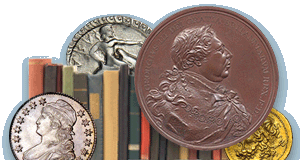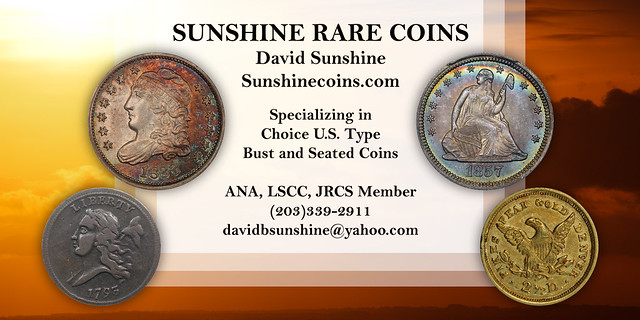
PREV ARTICLE
NEXT ARTICLE
FULL ISSUE
PREV FULL ISSUE
1804 DOLLAR FAKES AND REPLICASE-Sylum Feature Writer and American Numismatic Biographies author Pete Smith submitted this article on fakes and replicas of the 1804 Dollar. Thanks! -Editor
1804 Dollar Fakes and Replicas
After my article last week, Wayne asked if anyone had a fake 1804 dollar. I found five examples in my collection. None are deceptive to an experienced numismatist. Let's begin the discussion by establishing some terms. No 1804 Dollar was struck at the Mint in 1804. There is no "Real" 1804 Dollar. Dollars dated 1804 and struck in 1834-35 are generally known as "Originals." Those struck around 1858 are generally known as "Restrikes." Both terms are not appropriate but have come to be understood. They may also be called "Authentic." If it isn't authentic, it is a fake. A "Replica" is a copy with the general appearance of a coin but not intended to deceive. A "Counterfeit" is a copy intended to deceive. How can a person tell if they have a genuine 1804 dollar or a fake? The 1973 Hobby Protection Act requires that replicas have the word "COPY" impressed on the coin. If your 1804 dollar shows the word "COPY," it is probably a fake. The 1804 Originals and Restrikes had lettered edges If your coin has a reeded edge, it is a fake. Authentic 1804 dollars had a diameter of 39 to 40 mm. Copies with a diameter of 37 mm or less are not authentic. Authentic 1804 dollars have a weight between 26.53 grams and 26.98 grams. If it weighs less than 26.5 grams or more than 27 grams, it is a fake. If a nineteenth-century merchant found an 1804 dollar, they could not look on the internet for a photo for comparison. They would have no access to the limited sources that might describe the coin. With Spanish silver still appearing in America, an 1804 Spanish 8 Reale might be mistaken for an 1804 American dollar. The same issue applies to counterfeits. It is tough to make a counterfeit coin without an original for comparison. The first newspaper reports of 1804 dollar discoveries are more likely to be misidentification rather than pieces designed to deceive. The problem of fakes was recognized and mentioned in The Numismatist for March 1899, on page 55. "Casts, electrotypes, altered dates and dollars made of lead are scattered over the land in profusion, and a number of extensive swindles have been perpetrated in past years." The Newman and Bressett book on The Fantastic 1804 Dollar has a chapter on "Alterations and Other Fakes " Several examples of altered date coins are mentioned. They also mention some of the stories of discoveries. Commenting on the Yale ice arena story, "This was obviously a planned hoax." The Philadelphia Mint produced electrotype copies of the unique Class II dollar in 1860. On May 5, 2022, one sold at auction for $21,600. Later on August 18, 2023, an example sold at auction for $11,400. The auction photos show these were both the same coin. William Idler was also known to produce electrotypes. When was the first electrotype 1804 dollar sold at auction? On the morning of October 7, 2025, I could not have told you. Later In the day I came across this quote. "The Mendes I Cohen collection, sold in 1875, was the first public offering of Idler's electrotypes." What is the source of this quote? It was something I wrote that was published in The Numismatist in September 1995, thirty years ago. Newman and Bressett do not mention struck copies suggesting they are a more modern curse on the market. When was the first struck copy made? I have seen no documentation. There appears to have been a gradual transition from fakes intended to deceive into replicas offered as copies or "tribute" coins. In October of 2025, there are more than a hundred struck copies offered on eBay with about thirty different types or varieties. Many have sold in the past three months. Newspapers did nothing to verify claims. Articles that mention people with 1804 dollars never bother to describe the design, diameter, weight or edge. There are no follow-up articles when pieces are discredited I suspect that Wayne and I have stumbled upon a neglected area of numismatic research. While much has been published to trace the pedigrees for sixteen "authentic" 1804 dollars, there is little documentation for claimed 1804 dollars that prove to be false. Circling back to terms, the broad field of 1804 dollars include original coins, restrike copies, misidentifications, electrotypes, altered dates, hoaxes, cast copies, struck copies. tribute coins, bullion pieces, novelties and fantasies. What have I left out?
* * * * * * *
Attached is a newspaper clipping from The Miami Herald for November 18, 1965. The article appears in four other Florida papers. The photo shows a close-up of the coin with enough detail to compare to the original. I see minor differences in the hair detail and drapery on the shoulder. A diagnostic is the position of the thirteenth star relative to the point of the bust. It is another fake.
* * * * * * *
This week I have looked at hundreds of photos of 1804 Dollar replicas, I found eight different examples of coins with Class III Reverse that are not marked as copies. All have diagnostic marks to distinguish them from restrikes but could fool a casual collector.
Wayne Homren, Editor The Numismatic Bibliomania Society is a non-profit organization promoting numismatic literature. See our web site at coinbooks.org. To submit items for publication in The E-Sylum, write to the Editor at this address: whomren@gmail.com To subscribe go to: Subscribe All Rights Reserved. NBS Home Page Contact the NBS webmaster 
|


